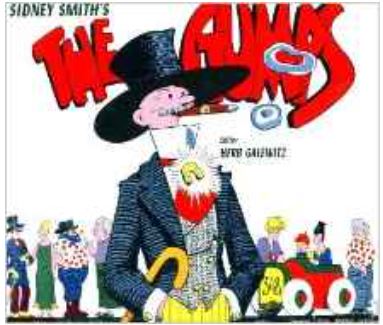
By Sidney Smith, edited and compiled by Herb Galewitz (Charles Scribner’s Sons)
ISBN: 978-0-68413-997-5 (HB)
This book includes Discriminatory Content produced during less enlightened times.
There are so many milestones of the art of comics that new or casual readers can’t enjoy these days. The literary pioneer celebrated in this book is probably the most important of all 20th century US cartoonists, but other than this rare-as-hen’s-teeth tome and a single Library of American Comics Essentials collection (The Saga of Mary Gold) there’s precious little to be seen of his greatest invention – in English at least. Chances are you’ve never heard of him, but Robert Sidney Smith (February 13th 1877 – October 20th 1935) is arguably the most influential creator in the history of popular entertainment. A pretty big claim, I admit, but true nonetheless.
Smith was a pioneer of narrative continuity and the most successful early cartoonist to move the medium on from situational, gag-a-day variations on a character (a style dominant again today) to build with his avid audience an ongoing relationship based on character development and story progress. The Gumps grew from a notion expressed by influential comic strip Svengali Joseph Medill Patterson – Editor and Publisher of the Chicago Tribune – who shaped the development of such iconic institutions as Little Orphan Annie, Gasoline Alley, Dick Tracy, Terry and the Pirates and so many more. He handed his idea to Smith to make magic with…
The ongoing saga of a middle class American family began in 1917 and ran for 42 years, inviting readers to share the largely comedic tribulations of chinless wonder Andy Gump, his formidable wife Minerva, son Chester, cat Hope, dog Buck and fearsome Tilda, the family’s aging cook, housemaid, gadfly and critic
Andy was a regular guy: a blowhard with lots of schemes to make his fortune, Min was shrewish and nagging, the boys were troublesome and Tilda was a nosy tartar and the already infinite plot well of their domestic set-up sporadically drifted into thrilling adventure and flights of fancy whenever eccentric, two-fisted globetrotting millionaire Uncle Bim paid a visit…
It sounds hackneyed now, but that’s because The Gumps literally wrote the book on what daily story narratives should be: a lot of laughs, plenty of vicarious judgement, an occasional tragedy, oodles of long-drawn out tension and archetypal characters every reader recognised if not actually identified with…
Having enticed and beguiled a nation, The Gumps was one of the earliest strips to make the jump to celluloid. More than four dozen Universal Pictures 2-reel comedies were released between 1923 and 1928 starring Joe Murphy as the gormless patriarch. These followed 50 or more animated cartoons first seen between in 1920 and 1921, produced and directed by Wallace A. Carlson with scripts credited to Smith.
The Gumps was an early sensation of radio (1931-1937), paving the way for all later family soap operas which mimicked its irresistible format. Most importantly, as the strip progressed, its rocketing popularity became a key driver in the rise of comics syndication. Eventually Sidney Smith’s baby was seen across America and the world and he became one of the most highly-paid artists in the history of the medium. His salary was enormous and kept rising, as the grateful Patterson constantly rewarded him with some new extravagance to show his gratitude. The legend goes that racing-mad speed-freak Smith was driving his latest luxury Rolls Royce when he died in a smash-up in 1935…
After his shocking death, Patterson parachuted in sports cartoonist Gus Edson: a creditable replacement but ultimately unable to recapture the indefinable pizzazz of the originator. Whether it was something unique to Smith or simply that times and tastes were changing will never be known. Readership declined steadily but it took decades before the feature finally folded on October 17th 1959, by which time less than 20 papers carried it.
There will probably never be a comprehensive or complete Gumps archival collection. The spiky but compelling art is still manically wonderful and most of the gags remain well-conceived and effective, but the real problem is the pacing and verbosity of the text in the panels. Smith was writing and drawing a whole new way to tell stories and had to be sure the majority of his audience were with him. For most modern readers – blessed with a 100+ years of progress – much of the material might seem interminably slow. Not so back then: many of Smith’s boldest innovations caused uproar and shock on a periodic basis…
This sterling and scholarly monochrome landscape tome from 1974 still pops up now and again, offering the best of all possible worlds; extracting salient snippets, events and extracts from key storylines whilst providing fascinating commentary and context where necessary.
On Thursday February 8th 1917 Sidney Smith’s funny animal strip Old Doc Yak ended with the sagacious ruminant moving out of their house and wondering who the next tenants might be. The following Monday – February 12th – the doors opened on the Gump clan. The magic started strong and just kept on going…
Packed with photos and plenty of astonishing facts, Herb Galewitz’s ‘Introduction’ offers the run-down on the strip and its creator whilst also providing a glimpse at the star in the making through ‘Sidney Smith’s Sports Cartoons’. Also revealed are ‘The Last Old Doc Yak’ strip and a handy pictorial introduction to the incoming cast before ‘The Early Years: 1917-20’ sees the stories begin to unfold…
Scenes of wedded bliss and domestic contention abound as Andy & Min contend with household chores, wayward furnaces, gardening, child-rearing and each other. As ticked off as they ever got, the happy marrieds seldom let adversarial moments linger or fester…
‘Andy On Vacation – 1922’ shows our hero’s take on bucolic pastimes like fishing, hiking and cooking after he and Min take separate holidays. Andy finds himself at a lakeside cabin with the least welcoming couple in history. Mr. Gump doesn’t mind: it takes all sorts and he’s willing to be accommodating…
The satire cup overflows when the pontificating prawn then enters politics. ‘Andy Runs for Congress – 1922’ proffers plenty of scope for character assassination, skulduggery and corrupt shenanigans before all the votes are finally cast and counted…
The Gumps truly hit its peak after moving wholeheartedly into melodrama, as with ‘The Vindication of Tom Carr – 1929’, wherein romantic regular Mary Gold’s one true love was wrongfully convicted of robbery. Smith sagely portrayed the trial through daily bulletins which built tension and sympathy in equal amounts. When the travesty of justice saw the real culprit rapaciously move in on Mary, the aroused assembled readership was aghast and astoundingly vocal in their protests…
They went absolutely crazy when the vile predator’s machinations led shockingly to ‘The Death of Mary Gold – 1929’. The story even moved from the comics section to Front Page as readers registered their disapproval. Circulation of papers carrying The Gumps skyrocketed…
Uncle Bim was an exotic semi-regular whose appearances always caused sparks. His lonely years of prospecting and wealth-gathering looked likely to end when he met Millie De Stross but her social-climbing mother had other ideas. These brought her to near-ruin after the gullible old lady encountered unscrupulous embezzler/conman Townsend Zander who masqueraded as royalty in ‘The Count Bessford Affair – 1933’…
With Mama firmly in the crook’s pocket, the scoundrel demanded marriage to Millie as part of his pay-off. When that went wrong he resorted to kidnap and blackmail. Audiences were breathless and terrified. Their favourite funny page feature had a track record of letting good guys suffer and killing off heroines…
When ‘The Disappearance of Uncle Bim – 1933’ was finally resolved, the distraught millionaire rushed his intended to the altar, but Zander had one last card to play, resulting in ‘A Foiled Wedding! – 1934’…
The villain’s outrageous claim to have already wed Millie led to courtroom drama and ‘A Legal Hassle! – 1934’, allowing reprehensible, haughty Mama De Stross to sue Bim for his fortune, so Andy took the beleaguered suitor to his old holiday haunt for ‘An Interlude at Shady Rest – 1934’…
Batteries fully recharged, the irrepressible Gumps returned to the fray to finally outwit Mrs. De Stross and defeat Zander, resulting in a long-delayed happy ending (of sorts) with ‘Bim and Millie, United at Last – 1934’. Of course that meant the newlyweds had to cope with ‘Mama De Stross, Mother In Law – 1934’…
These too-brief tastes of Smith’s amazing graphic narrative achievements are supplemented by a selection of shorter vignettes such as a glimpse at the unique service of housemaid ‘Tilda’ and the wiles of child prodigy ‘Chester Gump’ as well as a peek at the efforts of his successor in ‘Gus Edson’s The Gumps’. Also included is an appreciation of Smith’s gag-panel, uncomfortably displaying the “oriental wisdom” of ‘Ching Chow’. Although disquieting to modern eyes, this philosophy-spouting comedy “Chinaman” first appeared on January 27th 1927 and also carried on after Smith’s death, initially rendered by Stanley Link. Regarded as an irreplaceable cartoon “fortune cookie” by countless editors, the panel was crafted by a succession of creators and ran until June 4th 1990 (!!), outliving The Gumps by almost 40 years…
The examples seen here are counterbalanced by a ‘Comparison of Chester Gump and Stanley Link’s Tiny Tim’ and followed by a photo-feature ‘Miscellany’ displaying a wide range of Gumps books and merchandise to end this cartoon celebration…
Studious and genuinely enticing for students of comics and anybody interested in the evolution of soap operas and sitcoms, this book provides insight and a fascinating visual tour of a phenomenon and world we’ve mostly outgrown, but one still worth celebrating and commemorating.
© 1974 The Chicago Tribune/N.Y. News Syndicate Inc. All rights reserved.
















